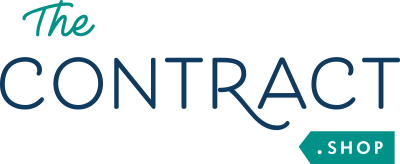Your Cart is Empty
Shop confidently - 14-day no-hassle return policy
Shop confidently - 14-day no-hassle return policy
Shop confidently - 14-day no-hassle return policy
You’ve been minding your own business, following your passion, and all of a sudden realized that this passion might actually be becoming a business. Only, you didn’t plan to start a business, and you have no idea where to even begin. If only you had a handy “starting a business checklist” to reference.
The good news? You’re wise enough to realize that there are legalities to handle, and they’re most definitely not worth putting off.
The bad news? There is none because you were ALSO wise enough to find The Contract Shop ®, where we believe in helping business owners establish a trustworthy [and legal] foundation.
Before you can apply for your business license, there are a few things you’ll need to do.
There are five business entities that you’ll want to consider before determining which is best for your new business. And while it’s a big decision that you certainly want to carefully think over, you aren’t locked into whatever you decide for good. However, keep in mind that some entities offer you more protections than others.
A Sole Proprietorship is the easiest type of business entity to form. This is due to the fact that the business is seen as a personal venture of the owner, profit is reported through your own 1040, which makes taxes simpler.
However, a Sole Prop is not seen as a separate entity from the business owner. Meaning that ALL of the liability is on you. Your personal assets aren’t seen as separate, and if someone sues the business? They’re suing YOU.
And because we’re all about protecting yourself and your business … It should come as no surprise that we don’t recommend choosing a Sole Prop when starting your business.
LLC’s, on the other hand, offer both flexibility and protection. Within LLCs, there are quite a few types to choose from. We won’t go into all of them, but most common for small businesses are single-member LLCs.
With a single-member LLC, you’re taxed as a sole proprietorship (unless you elect to be taxed as a corporation), but you have the protection that comes from being a separate entity from your business. If the business gets sued, your personal assets are protected.
Is your new business philanthropic? A non-profit structure might be the best fit for you. Typically operated by a board of directors instead of one owner, these ventures are dedicated to furthering a social cause. While a non-profit means you aren’t taking any profit as an owner, this business structure means you still receive some of the same protections as other business structures.
A C Corp is a type of corporation that is recognized as completely separate from its owners. When it comes to taxes, the corporation itself is taxed on its profits and the owners are also taxed on any profits they receive.
These are typically much larger companies with multiple shareholders (owners) and employees, and have lost popularity since LLCs came on the scene in the 90s. There are some perks, like limited liability protection for its owners, but in all likelihood this won’t be a business type you’ll consider.
An S Corp, on the other hand, is also a separate entity from its owner(s) and will offer limited liability protections to shareholders (owners) but is taxed differently than a C Corp. Instead of the double taxation that a C Corp is subject to, an S Corp is taxed as a pass-through entity (similar to an LLC).
In layman's terms? The profits and losses are passed-through to owners’ personal tax returns. Even better? An S Corp only pays taxes on the profit that remains after employees and shareholders are paid.
Another important step to take on our “before starting a business checklist” is to choose a name. When it comes to a business name, you want something that is:
And, of course, available. You’ll want to ensure that the name you come up with isn’t Trademarked, is not already in use in your State, AND is available as a domain.
Quick Tip: Don’t rush this part of the process. Give yourself permission to brainstorm, agree that there are no bad ideas, and test out your potential names with friends and family to get a feel for them.
But at the end of the day? Remember that there’s no perfect name, and at some point you’ll just need to move forward with your best choice.
An EIN is essentially your business’ social security number. You’ll want to have it for things like opening a business bank account, filing tax returns, applying for business licenses, and more.
This blog post has full step-by-step instructions for setting up your EIN. Go ahead and bookmark that for when you’re ready to set yours up.
This step isn’t a requirement, but boy do we recommend it (and couldn't complete our starting a business checklist without it). When it comes to staying on top of the legalities of running your business, it’s not a full time job, but it IS an important one. And the last thing you want to do is be unable to find important information when you need it, simply because it’s been so long since you put your hands on it that you’ve just plain forgotten where you tucked it away for safekeeping.
Inside your business binder, we recommend storing all of your important documents surrounding:
You can put one of these together yourself, or you can grab our premade version for less than $50. We’ll walk you through exactly what to put inside, and how to organize it.
Once you’ve taken these initial steps, you’ll be well on your way to officially becoming a business owner. Congratulations! But before you pop the champagne, you’ll want to make sure you know what steps you need to take to actually start the business, and then what steps you’ll need to take to maintain your business.
Don’t worry - we’ve got you covered for all of that, too. In fact, we’ve created a handy checklist for you to print out and add to your business binder. You can grab that for free here!
Amanda Warfield is a simplicity-focused content marketing and launch strategist, author of the book Chasing Simple Marketing, and host of Chasing Simple - a podcast to help creative entrepreneurs uncomplicate their marketing and business. She traded in her classroom lesson plans for speaking and educating creative entrepreneurs on sustainably fitting content marketing into their business, without it taking over their business - so that they have time to grow their business.
Comments will be approved before showing up.

Take our 1-minute Business Quiz and get personalized advice delivered straight to your inbox!
